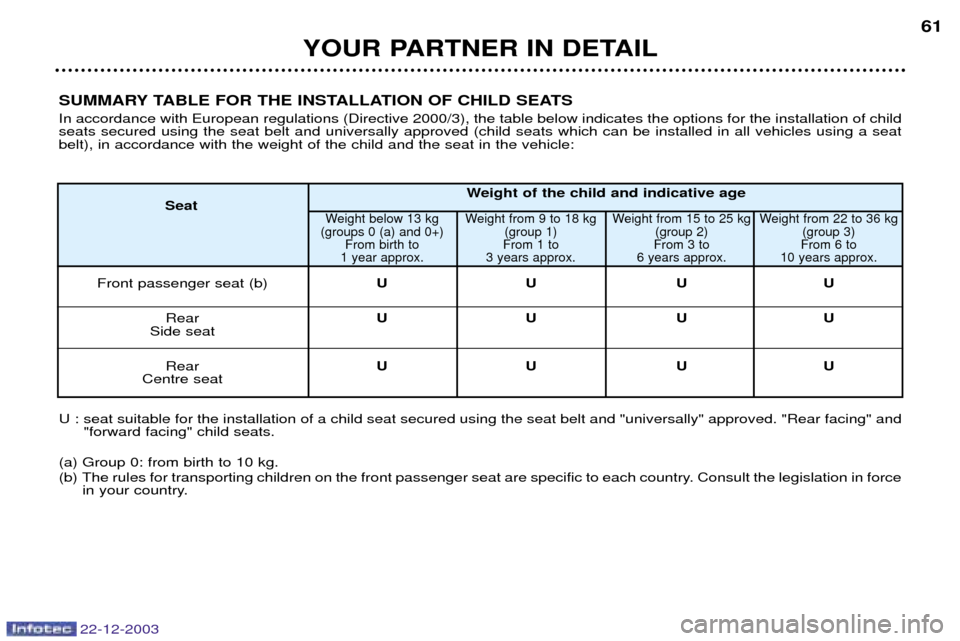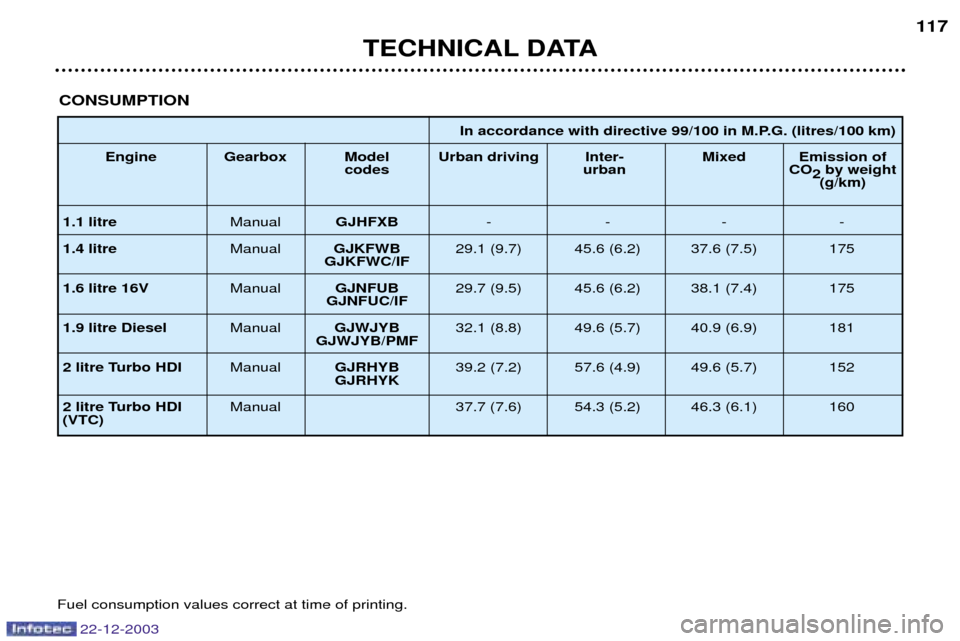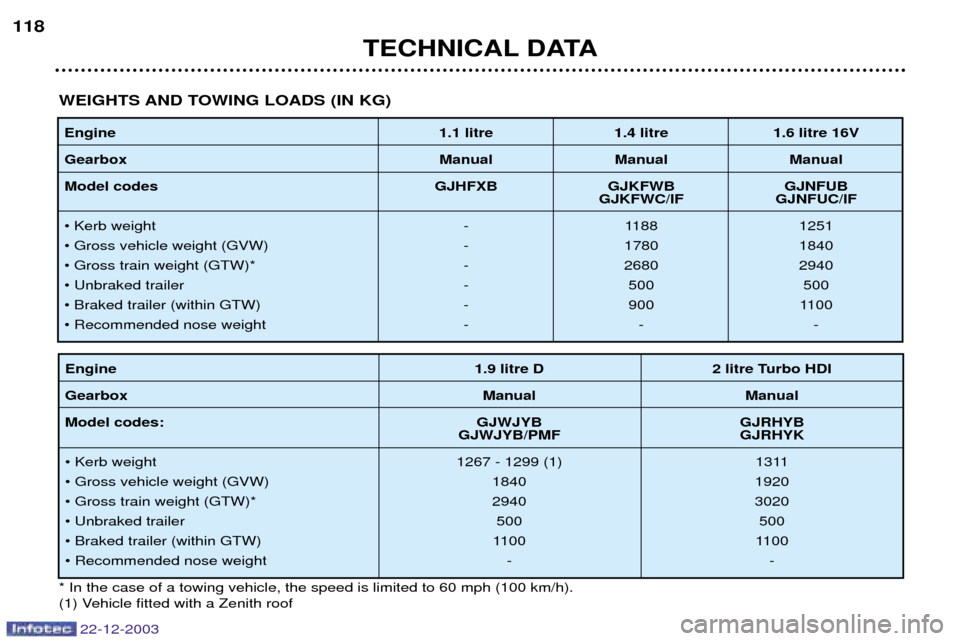2004 Peugeot Partner VP weight
[x] Cancel search: weightPage 14 of 128

22-12-2003
PEUGEOT SERVICING
Your vehicle benefits from extended service intervals.
¥ For petrol engines: every 20,000 miles (30 000 km) or every two years.
¥ For direct injection diesel engines: every 12,000 miles (20 000 km) or every two years.
¥ For indirect injection diesel engines: every 10,000 miles (15 000 km) or every two years.
Your service indicator informs you when a service is due; the point at which a service is due is calculated from the last indicator zero reset (see corresponding section). This point is determined by two parameters:- the distance travelled,- the time elapsed since the last service.Note:the distance remaining may be weighted by the time factor, depending on the driver's style of driving.
The extension of the service intervals means that the engine oil level must be checked regularly: topping up of the oil between oil changes is normal. This is why the PEUGEOT network is offering you an intermediate service between regular services.
The date of this visit is not shown by the service indicator. It is to be carried out at least every 10,000 miles (15 000 km) for petrol engines; every 6,000 miles (10 000 km) for direct injection diesel engines and every 5,000 miles (7 500 km) for indirect injection diesel engines.
A PEUGEOT dealer will carry out a quick check and top up the levels if necessary (oil, coolant, windscreen wash up to 2 litres). If the oil level is too low there is a risk of serious damage to the engine: check the engine oil level at least every 2,000 to 3,000 miles (3 000 to 5 000 km), depending on the conditions of use. This extended servicing has been made possible by modifications to our vehicles and to the lubricants:
THUS IT IS ESSENTIAL TO USE ONLY LUBRICANTS WHICH ARE SUITED TO YOUR ENGINE AND RECOMMENDED
BY THE MANUFACTURER (see "Lubricants" pages).
PEUGEOT SERVICING
18
Page 57 of 128

YOUR PARTNER IN DETAIL57
22-12-2003
Rules for transporting children on the front passenger seat** Children under the age of 10 must not travel in the forwards facingposition, unless the rear seats arealready occupied by other childrenor the rear seats cannot be used(absent or folded). In this case,adjust the front passenger seat tothe intermediate position and leavethe passenger air bag armed. The transportation of children in the rearwards facing position is permit-ted. In this position, it is essential todisarm the passenger air bag.Otherwise, the child would risk beingkilled or seriously injured if the airbag were to inflate.GENERAL POINTS RELATING TO CHILD SEATS Although one of PEUGEOT's main criteria when designing your vehicle, the safety of your children also depends on you.
For maximum safety, please follow these precautions:
- Since 1992,
all children under the age of 10 must travel in approved child
seats* suited to their weight , on seats fitted with a seat belt.
- A child weighing less than 9 kg must travel in the rearwards facing
position both in the front and in the rear. PEUGEOT recommends thatchildren should travel in the "rearwards facing" position up to the age oftwo.
- Statistically, the safest seats in your vehicle for the transportation of children are the rear seats. PEUGEOT recommends that children travel inthe rear even when a "rearwards facing" child seat is used.
- If a child is travelling on a booster seat, check that the lap section of the seat belt passes over the child's thighs correctly. The chest section of the seat beltmust be positioned on the child's shoulder without touching the neck.
PEUGEOT recommends that you use a booster seat with a back, fitted with aseat belt guide at shoulder level.
- Remember to fasten the seat belt or the child seat harness keeping the slack
in relation to the child's body to a minimum , even for short journeys.
* According to current legislation in the country.
** Consult the relevant administration in your country for information regarding the rules for transporting children on the front passenger seat.
Page 61 of 128

22-12-2003
YOUR PARTNER IN DETAIL61
U : seat suitable for the installation of a child seat secured using the seat belt and "universally" approved. "Rear facing" an d
"forward facing" child seats.
(a) Group 0: from birth to 10 kg.
(b) The rules for transporting children on the front passenger seat are specific to each country. Consult the legislation in fo rce
in your country.
SUMMARY TABLE FOR THE INSTALLATION OF CHILD SEATS In accordance with European regulations (Directive 2000/3), the table below indicates the options for the installation of child seats secured using the seat belt and universally approved (child seats which can be installed in all vehicles using a seatbelt), in accordance with the weight of the child and the seat in the vehicle:
Weight of the child and indicative age
Seat
Weight below 13 kg Weight from 9 to 18 kg Weight from 15 to 25 kg Weight from 22 to 36 kg
(groups 0 (a) and 0+) (group 1) (group 2) (group 3) From birth to From 1 to From 3 to From 6 to
1 year approx. 3 years approx. 6 years approx. 10 years approx.
Front passenger seat (b) UU UU
Rear UU UU
Side seat
Rear UU UU
Centre seat
Page 120 of 128

TOWING A TRAILER,
CARAVAN, BOAT etc.
Only use original PEUGEOT tow bars that have been tested andapproved from the design stage of
your vehicle. The tow bar must be
fitted by a PEUGEOT dealer.
Your vehicle is primarily designed for transporting people and luggagebut it may also be used for towing a
trailer. Driving with a trailer subjects the towing vehicle to more significantstress and its driver must be particu-larly careful. Air density decreases with altitude, thus reducing engine performance.Above 1000 metres, the maximumtowing load must be reduced by 10% and so on for every 1000 metres of altitude.Driving advice Distribution of loads :
Distribute the
load in the trailer so that the heaviest items are as close as possible to theaxle and the nose weight approachesthe maximum permitted without exceeding it. Cooling : Towing a trailer on a slope
increases the temperature of the coolant. As the fan is electrically controlled, its cooling capacity is not dependenton the engine speed.
On the contrary, use a high gear to lower the engine speed and reduceyour speed. The maximum towing load on a long slope depends on the gradient andthe outside temperature. In all cases, pay attention to the coolant temperature. If the warning light comes on, stop
the vehicle and switch off the engineas soon as possible. Tyres :
Check the tyre pressures of
the towing vehicle and of the trailer,observing the recommended pressures. Braking : Towing increases the
braking distance.Lights : Check the electrical signalling
on the trailer.Side wind : Take into acount the
increased sensitivity to side wind.
PRACTICAL INFORMATION 113
22-12-2003
Page 124 of 128

CONSUMPTION
Fuel consumption values correct at time of printing.In accordance with directive 99/100 in M.P.G. (litres/100 km)
Engine Gearbox Model Urban driving Inter- Mixed Emission of codes urban CO 2by weight
(g/km)
1.1 litre ManualGJHFXB ----
1.4 litre ManualGJKFWB 29.1 (9.7) 45.6 (6.2) 37.6 (7.5) 175
GJKFWC/IF
1.6 litre 16V ManualGJNFUB 29.7 (9.5) 45.6 (6.2) 38.1 (7.4) 175
GJNFUC/IF
1.9 litre Diesel ManualGJWJYB 32.1 (8.8) 49.6 (5.7) 40.9 (6.9) 181
GJWJYB/PMF
2 litre Turbo HDI ManualGJRHYB 39.2 (7.2) 57.6 (4.9) 49.6 (5.7) 152
GJRHYK
2 litre Turbo HDI Manual 37.7 (7.6) 54.3 (5.2) 46.3 (6.1) 160
(VTC)
TECHNICAL DATA 117
22-12-2003
Page 125 of 128

22-12-2003
TECHNICAL DATA
118
Engine
1.1 litre 1.4 litre 1.6 litre 16V
Gearbox Manual Manual Manual
Model codes GJHFXB GJKFWB GJNFUB
GJKFWC/IF GJNFUC/IF
¥ Kerb weight - 1188 1251
¥ Gross vehicle weight (GVW) - 1780 1840
¥ Gross train weight (GTW)* - 2680 2940¥ Unbraked trailer - 500 500
¥ Braked trailer (within GTW) - 900 1100
¥ Recommended nose weight - - -
WEIGHTS AND TOWING LOADS (IN KG) * In the case of a towing vehicle, the speed is limited to 60 mph (100 km/h).
(1) Vehicle fitted with a Zenith roof
Engine 1.9 litre D 2 litre Turbo HDI
Gearbox Manual Manual
Model codes: GJWJYB GJRHYB
GJWJYB/PMF GJRHYK
¥ Kerb weight 1267 - 1299 (1) 1311
¥ Gross vehicle weight (GVW) 1840 1920
¥ Gross train weight (GTW)* 2940 3020¥ Unbraked trailer 500 500
¥ Braked trailer (within GTW) 1100 1100
¥ Recommended nose weight - -